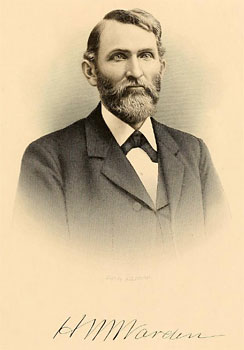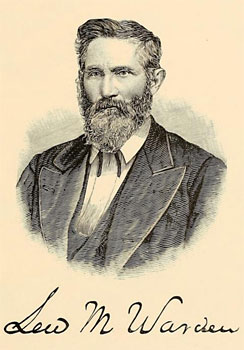H. M. WARDEN
 The portrait of one of San Luis Obispo’s most fortunate and popular citizens is here given, and an illustration on another page represents what is claimed as the handsomest residence in San Luis Obispo County, with its fine gardens, costly marble fountain, and all the rich adornments of an elegant country home. This is the home of Horatio Moore Warden, a native of Ohio, born at Granville, Licking County, May 13, 1828. Mr. Warden springs from old colonial stock of high rank, who, when the difficulties came between the colonies and the mother country, espoused the patriot cause, and upon the declaration of independence became a Captain in the American Army, continuing in the field through the Revolutionary War. Mr. Warden’s father was Gabriel Warden, a native of Burlington, Vermont, and his mother’s maiden name was Mary Seely, a native of Massachusetts. This worthy couple raised a family of twelve children, three of whom were daughters and nine sons, the subject of this sketch being next to the youngest. Granville was noted for its excellent schools, and there young Warden received his education and grew to man’s estate. When twenty years of age, in company with two older brothers, he went from Ohio to Illinois, where they engaged in dealing in cattle, supplying the Chicago market. In that business they were engaged two years, during which time they resided in Marshall County in that State. In 1850, in company with Lew M. Warden, his brother, he crossed the plains to California, reaching Hangtown (Placerville) July 6th, making an exceedingly rapid journey for that period, including a stay of one week at Salt Lake City. The mines were then in their freshness, and virgin ground, enriched with the precious dust, was accessible to all, and in the mines of Placerville he immediately went to gathering gold. Subsequently, he mined on the American River, meeting with success generally, and soon accumulating sufficient capital to enable himself and brother to enter largely into business. In 1851 they went to Sacramento and established a livery stable, and put on a line of stages to Marysville, the first of the kind to that city.
The portrait of one of San Luis Obispo’s most fortunate and popular citizens is here given, and an illustration on another page represents what is claimed as the handsomest residence in San Luis Obispo County, with its fine gardens, costly marble fountain, and all the rich adornments of an elegant country home. This is the home of Horatio Moore Warden, a native of Ohio, born at Granville, Licking County, May 13, 1828. Mr. Warden springs from old colonial stock of high rank, who, when the difficulties came between the colonies and the mother country, espoused the patriot cause, and upon the declaration of independence became a Captain in the American Army, continuing in the field through the Revolutionary War. Mr. Warden’s father was Gabriel Warden, a native of Burlington, Vermont, and his mother’s maiden name was Mary Seely, a native of Massachusetts. This worthy couple raised a family of twelve children, three of whom were daughters and nine sons, the subject of this sketch being next to the youngest. Granville was noted for its excellent schools, and there young Warden received his education and grew to man’s estate. When twenty years of age, in company with two older brothers, he went from Ohio to Illinois, where they engaged in dealing in cattle, supplying the Chicago market. In that business they were engaged two years, during which time they resided in Marshall County in that State. In 1850, in company with Lew M. Warden, his brother, he crossed the plains to California, reaching Hangtown (Placerville) July 6th, making an exceedingly rapid journey for that period, including a stay of one week at Salt Lake City. The mines were then in their freshness, and virgin ground, enriched with the precious dust, was accessible to all, and in the mines of Placerville he immediately went to gathering gold. Subsequently, he mined on the American River, meeting with success generally, and soon accumulating sufficient capital to enable himself and brother to enter largely into business. In 1851 they went to Sacramento and established a livery stable, and put on a line of stages to Marysville, the first of the kind to that city.
Pursuing that business successfully for one year, he sold out in Sacramento and removed to Placer County, where he established lines of stages from Auburn to Yankee Jim’s, Iowa Hill, and Illinoistown. From 1852 to 1856, during the busy times of mining in Placer County, he maintained these stage lines, which were very profitable to their owner. April 15, 1856, while in Placer County, he married Miss Maria Mercedes Villigran. This esteemed lady died April 13, 1881, at their home in San Luis Obispo County. In 1856 he sold his business and removed to Napa County, where he purchased a farm which he successfully cultivated for twelve years, until, in 1868, he removed to San Luis Obispo County, where he has since lived. After coming to this county he engaged in sheep and wool growing, which he carried on with the good success that usually attended his enterprises. The necessity of a bank of deposit and exchange, there being none in the county, was very apparent, and in 1872, in company with C. H. Phillips, established the bank of Warden & Phillips, of which Mr. Warden was President, until he severed his connection with it. This is now the Bank of San Luis Obispo, and is an incorporated institution.
November 30, 1882, he married Miss Queenie Parr, daughter of Mrs. Loraine Page Parr, at the residence of the mother, in Grass Valley, Nevada County. The mother is a native of Granville, the native place of Mr. Warden, and an acquaintance of former years. Mrs. Warden is a native of Iowa. The kind heart of Mr. Warden is shown in the adoption and great care of two children, to whom he has given his name and treats as his own. Rosa Louisa Warden he has had in his family for several years, and Joseph Wilkinson Warden he adopted in September, 1882. Both are about thirteen years of age. In furnishing a pleasant home for these Mr. Warden is rewarded by the consciousness of doing good.
Mr. Warden and his family now reside on his splendid and highly improved ranch of 3,100 acres, being a portion of the Los Osos Grant, six miles from the city of San Luis Obispo. Here he indulges his taste for thoroughbred stock, having upon his place some very choice breeds of horses and cattle. His Short-horn Durhams are the pride of the country as well as of the owner, and his stock of all kinds is of the highest class.
The career of this gentleman has been one of almost uninterrupted success; coming as a young pioneer to California, he has passed through all the grades of enterprise, miner, stage proprietor, farmer, banker, until now he holds a princely estate of thousands of acres of the best of land, and a home of refinement and ease. The various steps through life have been taken with clear and good judgment, his business managed with honor and skill, all apparently being conducted without trouble, and bringing the natural result of wealth. In social and public life he has always borne a prominent part, being fond of good society, affable and pleasant to all, acting well to the motto of “suaveter in modo, fortiter in re,” which has brought him the regard and respect of all. Of the social and benevolent orders he is a member of the Free Masons and of the Independent Order of Odd Fellows. Politically he is a Republican, and has great influence in his party, taking great interest in public matters. In 1880 and 1881 he was one of the Supervisors of the county. He has also been a school trustee, and through his energy and exertions the fine public school building in San Luis Obispo has been erected. In all his business he has been thorough and exact, believing in the principle that all that is worth doing at all is worth doing well.
Source: History of San Luis Obispo County, California, between pp72-73. Transcribed for the CAGenWeb Project by Cathy Portz.
HON. LEW M. WARDEN
 Wherever one travels through the broad extent of California are found the grand estates, the public improvements and works of the early pioneers, the most convincing proofs of the remarkable energy, the great enterprise, the unflinching courage, the high intelligence and worthy character of the men who have built up the empire State of the Pacific Coast. One of these is met in the person of Hon. Lew Moore Warden, who recently represented San Luis Obispo County in the Legislature of California. This gentleman was born in Granville, Licking County, Ohio, May 22, 1825, his parents being Gabriel and Mary (Seeley) Warden; the father a native of Burlington, Vermont, and the mother of Massachusetts. His grandfather was an honored soldier of the Revolutionary War, serving as Captain during the struggle for our national independence. The family circle embraced twelve children, nine of whom were sons, and two of whom became California pioneers, the subject of this sketch, and H. M. Warden, whose biography also appears in this book. These two young men inheriting the stalwart physique, enterprise, and energy of their family, were of that class to lead into new countries, and act their part in the creation of new States. In 1848, Lew M. Warden, in company with an elder and a younger brother, the latter being H. M. Warden, went to Illinois, and engaged in the cattle trade, in supplying the Chicago market. In 1850, he and his younger brother came to California, across the plains and by Salt Lake City, where they stopped one week, arriving in the mines on Hangtown Creek on the 6th of July of that year. Until 1856 the two brothers acted in concert, engaged in mining, and staging in Sacramento, Yuba, and Placer Counties, carrying on their business with skill and judgment. Their various operations are more particularly detailed in the sketch of H. M. Warden.
Wherever one travels through the broad extent of California are found the grand estates, the public improvements and works of the early pioneers, the most convincing proofs of the remarkable energy, the great enterprise, the unflinching courage, the high intelligence and worthy character of the men who have built up the empire State of the Pacific Coast. One of these is met in the person of Hon. Lew Moore Warden, who recently represented San Luis Obispo County in the Legislature of California. This gentleman was born in Granville, Licking County, Ohio, May 22, 1825, his parents being Gabriel and Mary (Seeley) Warden; the father a native of Burlington, Vermont, and the mother of Massachusetts. His grandfather was an honored soldier of the Revolutionary War, serving as Captain during the struggle for our national independence. The family circle embraced twelve children, nine of whom were sons, and two of whom became California pioneers, the subject of this sketch, and H. M. Warden, whose biography also appears in this book. These two young men inheriting the stalwart physique, enterprise, and energy of their family, were of that class to lead into new countries, and act their part in the creation of new States. In 1848, Lew M. Warden, in company with an elder and a younger brother, the latter being H. M. Warden, went to Illinois, and engaged in the cattle trade, in supplying the Chicago market. In 1850, he and his younger brother came to California, across the plains and by Salt Lake City, where they stopped one week, arriving in the mines on Hangtown Creek on the 6th of July of that year. Until 1856 the two brothers acted in concert, engaged in mining, and staging in Sacramento, Yuba, and Placer Counties, carrying on their business with skill and judgment. Their various operations are more particularly detailed in the sketch of H. M. Warden.
After disposing of his stage property in Placer County, Mr. Warden sought the coast region, settling in Mendocino County, early in 1857, where he engaged in farming, and in the fall of that year was elected Sheriff of the county. There he displayed his usual business ability, making his farm a success, and, at the same time, attending to his duties as Sheriff. So satisfactorily did he conduct the shrievalty that he was often re-elected, holding the office continually for a period of ten years, until he decided to remove to San Luis Obispo County. To this county he came in 1867, purchasing a farm of 1,800 acres, a part of the Los Osos Rancho, and upon this he still resides, engaged in farming and stock-raising, and performing those public duties incident to the life of a prominent and popular citizen.
Since residing in this county he has held various positions of trust. For two years he was Supervisor of the county, in which service he gave satisfaction and gained the respect of all. In 1877 he was elected to the State Legislature on the Democratic ticket, with which party he acts politically. As a Legislator he was distinguished for his industrious and honorable course in his efforts to procure useful and economical legislation. He was a member of the Committee on Agriculture, Mining, and Mechanic Art College, and on Counties and County Boundaries. To the various duties he assiduously devoted his time and abilities, retiring from the office with a most honorable record.
Mr. Warden was married February 18, 1856, to Miss Helen M. Franklin, a native of St. Charles, Illinois. They have four children, two sons and two daughters, loved by their parents, and admired and respected by the community. The mother of Mrs. Warden, Mrs. Lydia Franklin, born in 1807, now nearly an octogenarian in age, resides in the family.
The home of Mr. Warden is on the Los Osos Rancho eight miles from the town of San Luis Obispo, where stand the old adobe buildings—see illustration —which were the residence of Capt. John Wilson, the former proprietor of the great rancho. This rancho, which was entitled the “Rancho Cañada de los Osos y Pecho y Islay,” was granted by the Mexican Government to Victor Linares, Francisco Badillo, James Scott, and John Wilson, and confirmed by the United States Courts to John Wilson, comprising an area of 32,430.76 acres of land. Captain Wilson was the stepfather of ex-Governor and Congressman Romualdo Pacheco, who grew to manhood on the estate. The venerable rancho has witnessed many changes in its history, passing from the quiet of the old mission era, through the period of revolution, the changes of dominion, the exciting times of the gold discovery, and the coming of the crowding, ambitious Americans, until it has entered the era of steady progression under the rule of enlightenment and improvement. As a cattle rancho it was always prominent, but where in former years it was distinguished for its numbers, it is now distinguished for the quality of the bovine and equine species that are bred upon it. In his stock Mr. Warden takes special pride. Thoroughbred horses and short-horned Durhams of the purest and finest blood are raised. Of the latter he has imported from the celebrated herds of Robert Ashburner, giving him the prestige of connection with that famous breeder.
Source: History of San Luis Obispo County, California, pp160-161. Transcribed for the CAGenWeb Project by Cathy Portz.
JOHN MCCORMICK WHITAKER
A venerable and respected citizen of San Luis Obispo County, who connects the living present with the men and history of the past. This gentleman was born February 11, 1801, in Clermont County, Ohio. That great State, now containing its millions of inhabitants, was then but a Territory, and all north and west almost unknown regions. There exists now on the North American Continent south of Alaska no land so little known and explored by the whites as was Ohio and the Northwest at that time, but during the life of this man the great changes and progress in civilization have been made that the most vivid imagination could not have conceived in the days of his youth. The systems of transportation by water and rail, now deemed indispensable, were scarcely thought of then, and the transmission of news as by the lightning flash, or the preservation of the human feature and the landscape view by the impression of the sun, were beyond the conception of the wildest dreamer. Mr. Whitaker has lived through and witnessed all these remarkable changes, and has followed the star of empire in its westward course. In vain has he kept in the van of civilization as it marched to the West. He could ask “Where is the West?” as the English poet asked,
“Where’s the North?
At York ’tis on the Tweed;
In Scotland at the Orcades; and there,
At Greenland, Zembla, or the Lord knows where.”
Mr. Whitaker made Ohio his home until he was twenty-six years of age, and then, in 1827, he moved into the wilderness of Michigan Territory, and there engaged in trading with the Indians. In this business he continued for seven years, until the United States bought out the Indians, and opened the country to the occupation of the farmer and settler. Then, in 1834, he moved westward across the Mississippi into that region now constituting the State of Iowa. At that time it was attached to the Territory of Michigan, having, since the admission of Missouri as a State, been a “political orphan,” without any government until June, 1834, when it was attached to Michigan. In 1836 it became a part of Wisconsin Territory, in 1838 was made the Territory of Iowa, and in December, 1846, became a State of the Union. At the time of the admission as a State, Mr. Whitaker had been a resident over twelve years, most of the time a Legislator, seeing the population increase from a few thousand along the “Black Hawk Purchase” and about the lead mining region of Dubuque to nearly 100,000. In the first State Legislature Mr. Whitaker was a member from Van Buren County, and before the Act of Congress was signed, admitting the State, the Legislature had assembled, and appointed him “Locating Agent” to select and locate the 500,000 acres of land donated the State for the purposes of internal improvements, but devoted by the Constitution to the support of schools. One section had been selected by William W. Dodge, who had been appointed by the Secretary of the Treasury, and Mr. Whitaker selected all the remainder excepting the small amount of 122 acres, as reported in the “History of the State of Iowa.” In this responsible duty he was engaged seven years, making all his explorations on foot, seeking the most suitable lands throughout the broad extent of the State, undergoing many hardships and encountering many dangers. The work, however, was ably and faithfully performed, as the grand and well-endowed system of schools, whereby Iowa can now have “school houses within one mile of each other,” as was the boast of a recent Governor, now proves. After the close of his duties as Locating Agent, Mr. Whitaker served one year in the Legislature, making about twenty years of Legislative and State service.
In 1861 he sought the farther West, crossing the plains to California, and soon thereafter located in San Luis Obispo County, settling on a ranch on San Simeon Creek, where he has since made his home. A view of the place is published in this volume, showing the modest home of this retired veteran. The ranch contains 320 acres of fine land, and is devoted to dairying.
Mr. Whitaker was married at the age of twenty-three, while still a resident of Ohio, to Miss Jane Phillips, who was also a native of that State, a daughter of one of Ohio’s pioneers, and this lady has been his companion through his many years of adventure, toils, and triumphs, dying at their home on the San Simeon, February 14, 1882, at the ripe old age of seventy-eight years. Six children had been born to them, five sons and one daughter, all of whom are still living. Mr. Whitaker, now of the advanced age of eighty-two, is still the capable and intelligent gentleman his active life of usefulness has shown, retaining all his faculties in a vigorous old age.
Source: History of San Luis Obispo County, California, pp335-336. Transcribed for the CAGenWeb Project by Cathy Portz.

